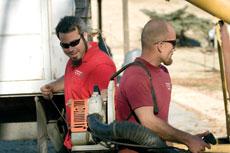University Pond sinks into controversy

Todd Wilkerson (left) and Mike Sobotka of Affordable Tree Service, Joplin, finish cleanup of the alterations made to the University Pond earlier this semester. The company consulted a conservationist for guidance.
After concern from students, faculty and staff, the Biology Pond has come under some debate.
The pond, now considered the University Pond, started as a spring-fed Olympic-sized swimming pool for the Mission Hills Mansion.
“Later, I don’t know when, they pushed in the walls and made it a pond,” said Bob Harrington, director of the Physical Plant. “Nobody has a record of why.”
He said he could estimate the change from old pictures of the former owners using the pool. From this, he guessed the pond was formed in the mid 1940s.
The University took ownership of the pond in the mid 1960s when, the then Joplin Junior College, bought the land.
The biology department started using the pond as an educational tool sometime before Harrington started working for Southern.
“It was already referred to as the Biology Pond when I got here,” he said.
Ten years ago, there was a move to change the pond.
“We received a contribution from a former regent for the memory of his son,” University President Julio León.
Russ Smith, the former regent, wanted the money to be used to create an oriental garden on campus.
“He’s always been an oriental garden admirer,” Harrington said. “We used part of the money then to replace the old bridge that used to be there.”
The old bridge was replaced with one of a more oriental tradition.
“We’ve just been waiting to continue the process,” he said.
The project was revived with talk of the rec center which is to be added onto the Billingsly Student Center.
León said there will be a view of the pond when the rec center is built.
The changes have upset some of the students.
Recently, the area was cleaned of dying and broken trees and a walking path was graveled.
Dave Henness, senior biology major, is one concerned student.
“There’s some destruction there when they moved the fence,” he said.
Henness said the area, including a marshland and walking trail, was cleaned of several natural animal habitats.
“They removed some of the under cover,” he said. “You couldn’t see the marsh and it acted as a natural barrier. Wood ducks used to nest in there. I’d be surprised if they came back this year.”
Some concerns involve whether or not the biology department will still be able to use the area for its studies.
“We have no intention of [harming the habitat],” León said.
Some faculty members say the idea is good, but lacks input.
“[The pond is] an integral part for the field courses,” said Dr. Karen Plucinski, department head of biology.
Harrington said the changes will not drastically change the pond area.
“Any one of the oriental gardens is to make it look as natural as possible,” he said. “We’ll be using natural plants native to the area.”
Dr. Dorothy Bay, associate professor of biology said the garden sounds good, but may hinder the department.
“It’s a lovely idea, but it restricts the use,” she said. “It’s a resource that has been available for a long time.”
León said the idea is to create a place where students can meditate in a peaceful atmosphere.
“It’s already there,” Henness said. “The Biology Club, we’ve already talked about installing benches along the trail.”
“It’s a beautiful place to mediate,” León said. “[We are] adding to what is already there.”
Harrington said the Physical Plant is also working on an old pump and well left by the old owners near the marshland. The pump will be used to help irrigate the soccer fields.
“It’s 250 feet deep,” he said. “The well had been closed and we pulled the casing out to check it.”
Henness is also concerned about this pump as it may take from the pond.
“From a purely ecological standpoint, they will have an effect,” he said.
Other students also expressed their concern over the pond.
“They (administrators) are just going ahead with this,” said Carolyn White, junior biology major. “They are not looking at student needs.”
White said she did an informal survey of non-biology students and said they were not likely to use the pond any more than they do already.
“You’re just harming the ecosystem,” she said. “We can still use it as it is.”
White and Henness suggested other areas on campus could be used to support another water element.
Harrington said he does not know the immediate plans for the pond, but has been researching the project to make sure it is as natural as it can be.
Your donation will support the student journalists of Missouri Southern State University. Your contribution will allow us to purchase equipment and cover our annual website hosting costs.



























